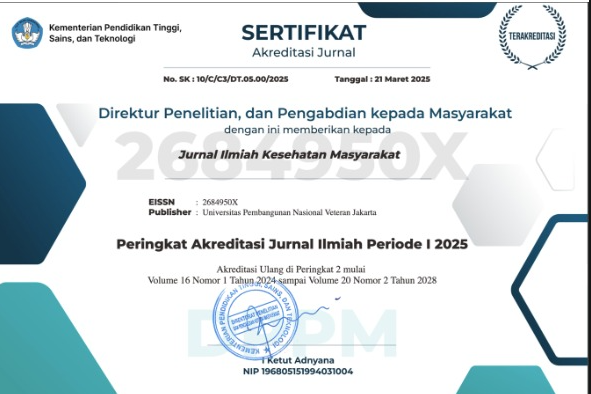ANALISIS KETAHANAN HIDUP PASIEN SEPSIS DI RUMAH SAKIT UMUM KABUPATEN TANGERANG
Abstract
Latar belakang: Sepsis yaitu adanya respon inflamasi karena infeksi. Ada beberapa faktor risiko yang dianggap berperan pada kejadian sepsis, antara lain usia, jenis kelamin, status pembiayaan, diabetes mellitus, infeksi saluran kemih, imobilisasi, decubitus, cardiac arrest, gangguan fungsi hati, gagal ginjal, pneumonia, peritonitis, pemasangan infus, kateter, intubasi, ventilator, kadar hemoglobin, albumin, leukosit dan trombosit.
Metode: Penelitian ini merupakan penelitian analitik dengan rancangan retrospektif yaitu menggunakan studi pendekatan kuantitatif dengan subjek dari data rekam medik pasien yang telah dirawat inap di ruang ICU dan perawatan penyakit dalam RSU Kabupaten Tangerang pada tahun 2016-2017. Menggunakan total sampling yaitu 126.
Hasil: Distribusi angka kematian tertinggi terdapat pada tahun 2016 yaitu sebanyak 76 pasien (55,0%) dan pada tahun 2017 yaitu sebanyak 62 pasien (44,9%). Variabel yang terbukti secara statistik memiliki hubungan yang bermakna dan merupakan faktor risiko adalah Diabetes Mellitus (p=0,032, Hazard Ratio=4,082; CI 95%= 1,128-14,768) dengan survival rate 11 hari, Cardiac Arrest (p=0,001, Hazard Ratio=3,446; CI 95%= 1,700-6,985) dengan survival rate 7 hari, Gagal Ginjal (p=0,000, Hazard Ratio=5,953; CI 95%= 2,479-14,294) dengan survival rate 8 hari, Pemasangan Kateter (p=0,072, Hazard Ratio=0,494; CI 95%= 0,229-1,065) dengan survival rate 17 hari, Pemasangan Intubasi Ventilator (p=0,010, Hazard Ratio=2,875; CI 95%= 1,285-6,434) dengan survival rate 13 hari.
Kesimpulan: Didapatkan gambaran distribusi kematian sepsis, analisis ketahanan hidup pasien sepsis serta variabel faktor yang berpengaruh terhadap kematian pasien akibat sepsis.
Background: Sepsis is the presence of an inflammatory response due to infection. There are several risk factors that are considered to play a role in the incidence of sepsis, including age, sex, financing status, diabetes mellitus, urinary tract infections,immobilization, decubitus, cardiac arrest, liver function impairment, renal failure, pneumonia, peritonitis infusion,intubation, ventilator, hemoglobin level, albumin, leucocytes and platelets.
Methods: This research is an analytical study with a retrospective design that uses a quantitative approach study with subjects from medical record data of patients who have been admitted to the ICU room and treatment of diseases in Tangerang General Hospital in 2016-2017. Using total sampling is 126.
Results: Distribution of the highest mortality rate was in 2016 as many as 76 patients (55,0%) and in 2017 that is as many as 62 patients (44,9%). Variables that were statistically proven to have a significant association and were risk factors were Diabetes Mellitus (p = 0,032, OR = 4,082; 95% CI = 1,128-14,768) with a survival rate of 11 days, Cardiac Arrest (p = 0,001, OR = 3,446; CI 95% = 1,700-6,985) with 7 days survival rate, Kidney Failure (p = 0,000, OR = 5,953; 95% CI = 2,479-14,294) with 8 days survival, Catheter Installation (p = 0,072, OR = 0,494; 95% CI = 0,229-1,065) with a 17-day survival rate, Ventilator Intubation Installation (p = 0,010, OR = 2,875; 95% CI = 1,285-6,434) with a 13-day survival rate.
Conclusion: Of this study shows the distribution of death sepsis, the factors that influence the patient's death due to sepsis and the survival rate of sepsis patients.









.jpg)








